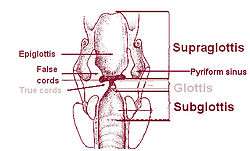Piriform sinus
| Pyriform sinus | |
|---|---|
 Pyriform sinus, a part of hypopharynx | |
 The entrance to the larynx, viewed from behind, with Pyriform sinus labeled at bottom left. | |
| Details | |
| Identifiers | |
| Latin | recessus piriformis, sinus piriformis |
| TA | A05.3.01.024 |
| FMA | 55067 |
| Anatomical terminology | |
On either side of the laryngeal orifice in humans is a recess, termed the piriform sinus (also piriform recess, pyriform sinus, piriform fossa, or smuggler's fossa), which is bounded medially by the aryepiglottic fold, laterally by the thyroid cartilage and thyrohyoid membrane. The fossae are involved in speech.
The term "piriform," which means "pear-shaped," is also sometimes spelled "pyriform" (as in the diagram on this page.)
Deep to the mucous membrane of the piriform fossa lie the recurrent laryngeal nerve as well as the internal laryngeal nerve, a branch of the superior laryngeal nerve.[1] The internal laryngeal nerve supplies sensation to the area, and it may become damaged if the mucous membrane is inadvertently punctured.
The piriform sinus is a subsite of the hypopharynx. This distinction is important for head and neck cancer staging and treatment.[2]
Clinical significance
This sinus is a common place for food particles to become trapped; if foreign material becomes lodged in the piriform fossa of an infant, it may be retrieved nonsurgically. If the area is injured (e.g., by a fish bone), it can give the sensation of food stuck in the subject's throat.
The persistency of the piriform sinus (especially on the left side) is a common cause of acute thyroiditis in children and adolescents. Local anesthesia can be given here because of the presence of the internal laryngeal nerve underneath the mucous membrane.
References
This article incorporates text in the public domain from page 1142 of the 20th edition of Gray's Anatomy (1918)
External links
- Anatomy photo:31:17-0105 at the SUNY Downstate Medical Center - "Pharynx: The Laryngopharynx"